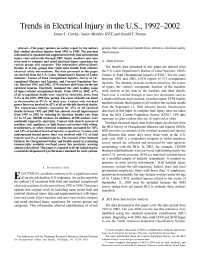Mining Publication: Trends in Electrical Injury in the U.S., 1992-2002
Original creation date: July 2008
This paper updates an earlier report by the authors that studied electrical injuries from 1992 to 1998. The previous information is expanded and supplemented with fatal and nonfatal injury rates and trends through 2002. Injury numbers and rates were used to compare and trend electrical injury experience for various groups and categories. This information allowed identification of at-risk groups that could most benefit from effective electrical safety interventions. The data presented in this paper are derived from the U.S. Labor Department's Bureau of Labor Statistics' Census of Fatal Occupational Injuries, Survey of Occupational. Illnesses and Injuries, and Current Population Survey. Between 1992 and 2002, 3378 workers died from on-the-job electrical injuries. Electricity remained the sixth leading cause of injury-related occupational death. From 1999 to 2002, 4.7% of all occupational deaths were caused by electricity, down from 5.2% in the 1992-1998 time period. The cause of death was listed as electrocution in 99.1% of fatal cases. Contact with overhead power lines was involved in 42% of all on-the-job electrical deaths. The, construction industry accounted for 47% of all electrical deaths between 1992 and 2002 but showed overall improvement from 1995 to 2002 by reducing its electrical fatality rate from 2.2 to 1.5 per 100 000 workers. In addition, 46,598 workers were nonfatally injured by electricity. Contact with electric current of machine, tool, appliance, or light fixture and contact with wiring, transformers, or other electrical components accounted for 36% and 34% of nonfatal electrical injuries, respectively. Contact with underground buried power lines was involved with 1% of fatal injuries and 2% of nonfatal injuries. The research of the National Institute for Occupational Safety and Health aimed at evaluating commercially available overhead power line proximity warning alarms is described. This paper is expected to be the initial step for eventual development of a performance standard for such systems.
Authors: JC Cawley, GT Homce
Peer Reviewed Journal Article - July 2008
NIOSHTIC2 Number: 20034352
IEEE Trans Ind Appl 2008 Jul-Aug; 44(4):962-972
See Also
- Electrical Safety
- Independent Contractor Trends in the United States Mining Industry
- Metal Operator Mining Facts - 2002
- Metal Operator Mining Facts - 2004
- Noncoal Contractor Mining Facts - 2003
- Nonmetal Operator Mining Facts - 2002
- Nonmetal Operator Mining Facts - 2008
- A Performance Evaluation of Two Overhead Power Line Proximity Warning Devices
- Sand and Gravel Operator Mining Facts - 2006
- Stone Operator Mining Facts - 2005
- U.S. Bureau of Mines/NIOSH Mining Electrical Safety Research: A Legacy of Protection Against Shock, Fires, and Explosions
- Content source: National Institute for Occupational Safety and Health, Mining Program


 ShareCompartir
ShareCompartir
